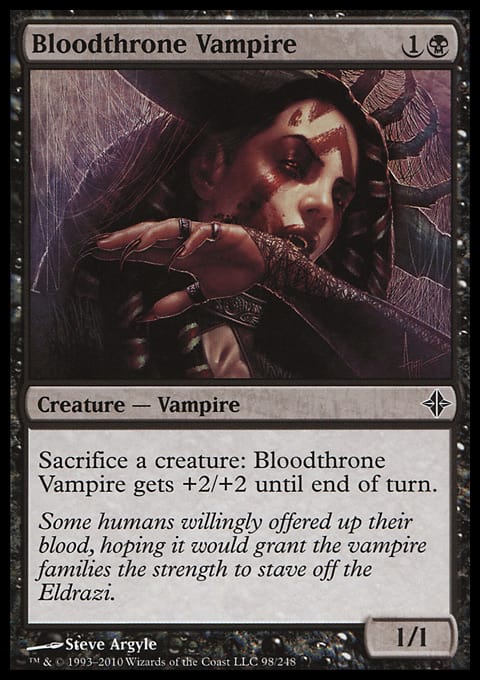C/Ube Archetypes and Misconceptions about Value
I love to cube. More specifically, I love common/uncommon cubing, henceforth referred to as C/Ube. You can find my list here. It’s because of this love that I want to spread the joys of drafting C/Ube with as many members of the Magic community as possible. But before I do that, I feel the need to first set the record straight. There is a misconception about what sort of environment C/Ube provides and misunderstandings as to how to draft decks that are both fun and successful within it.
A Brief Explanation of Cube and C/Ube
For those unfamiliar with cubing, a Cube is a collection of cards specifically designed to be drafted. In a Cube, nothing is off limits, and the Draft experience is a result of the cards you choose to include. The major distinction for C/Ube is the exclusion of rares and mythic rares. Because of this difference, the spectrum of power is much narrower. Where as in rare Cubes, you can go from Llanowar Elves to Upheaval, in C/Ube, it’s more like Llanowar Elves to Trostani's Summoner. That said, I designed my C/Ube with access to the most powerful effects possible without including cards deemed unfair or unfun (Skullclamp, Mana Drain, Library of Alexandria, etc.).
The Misconception
The most prevalent misconception about C/Ube is that it’s all about value—that is, cards that generate two-for-ones or better. Blatant offenders include Mulldrifter, Flametongue Kavu, Nekrataal . . . I admit the list is fairly long. Many approach C/Ube Draft thinking that without a critical mass of these cards in your Draft deck, all is lost. Even more disconcerting is the idea that because of this dynamic, all the games are slow, grinding, value mirrors wherein neither player is ever really ahead. In some cases, inexperienced C/Ubers may indeed generate a self-fulfilling prophecy. But I’m here today to show that, ultimately, this idea is far from the big picture.
Archetypes
I’ve had my C/Ube for about seven years now, and in that time, I’ve learned a lot about the format and my own build specifically. As new cards have been printed and included, the metagame has shifted, and today, several archetypes are clearly defined. Much like any Constructed format, it’s important to note there are good matchups and bad matchups. As most C/Ubes have a large number of cards in common, many of these archetypes will present themselves on their own. Most of the decks drafted in C/Ube can be defined as one of the following:
- Mono-White Aggro
- Mono-Red Aggro
- Mono-Black Aggro
- Two-Colored Aggro
- U/R Value
- U/B Value
- W/U Value
- Four- or Five-Colored Value
- Green-Based Ramp
- U/B Reanimator
- B/R(/g) Sacrifice (a.k.a. the Sam Black Special)
From these archetypes, we can delineate three main groups: aggro, ramp/combo, and value/control. I believe C/Ube can often be misunderstood because unfamiliar players may not realize so many of these decks are possible. Because of this, they tend to gravitate toward the aforementioned value cards, and depending on the table, a majority of the matches inevitably are value mirrors. Is this a fault of the unfamiliar players? Of course not. Is it a fault of the C/Ube? I don’t think so either.
This leads me to two conclusions. One, if a Cube owner is drafting with players new to his or her Cube, it’s beneficial to give them a quick rundown of supported archetypes. Two, if you’re unfamiliar with a Cube, it’s good to keep your eyes open for cards that signal an archetype. If Bloodthrone Vampire seems to be a weak black addition, chances are there might be more powerful ways of taking advantage of the card.
The Archetypes Explained
So, what’s needed to make each archetype successful? What are the good matchups? What are the bad? Let’s look at some example decks and try and answer some of those questions.
Mono- and Two-Colored Aggro
The most successful aggro decks in C/Ube are mono-colored. While the same is mostly true for rare Cubes, it’s even more so in C/Ube because of the absence of dual lands that enter the battlefield untapped. Aggro decks trade power for speed, and spending the first turns of the game developing their mana is simply not something they can afford. This speed allows them to prey on some of the slower, midrange and control strategies that do spend the early turns setting up big spells and mana bases.
While mono-red is the go-to aggro deck, both white and black have successful builds and offer their own advantages. What white trades for in the reach of red’s burn spells, it gains in cards that produce multiple threats (for example: Shrine of Loyal Legions, Spectral Procession, Cloudgoat Ranger, etc.). Conversely, black offers the highest concentration of 2-power 1-drops and disruption spells such as Inquisition of Kozilek and Hymn to Tourach. Land destruction is something that can be offered in both black and red, and it’s something I’ve tried in both but ultimately cut from black. In order for that package to work, players had to be very aware that it existed and go after it aggressively. Too often, those cards remained split up among sideboards. That said, it does have the potential to be a powerful tool.

"Mono-Red Aggro"
- Creatures (13)
- 1 Ashenmoor Gouger
- 1 Avalanche Riders
- 1 Fire Imp
- 1 Frenzied Goblin
- 1 Guttersnipe
- 1 Lightning Mauler
- 1 Mogg Fanatic
- 1 Rakdos Cackler
- 1 Rakdos Shred-Freak
- 1 Reckless Waif
- 1 Slith Firewalker
- 1 Stingscourger
- 1 Torch Fiend
- Spells (11)
- 1 Burst Lightning
- 1 Dismember
- 1 Fireblast
- 1 Incinerate
- 1 Lightning Bolt
- 1 Mutagenic Growth
- 1 Chain Lightning
- 1 Molten Rain
- 1 Rift Bolt
- 1 Chimeric Idol
- 1 Shrine of Burning Rage
- Lands (16)
- 15 Mountain
- 1 Mishra's Factory

"Mono-White Aggro"
- Creatures (16)
- 1 Accorder Paladin
- 1 Attended Knight
- 1 Azorius Guildmage
- 1 Cloistered Youth
- 1 Cloudgoat Ranger
- 1 Doomed Traveler
- 1 Dryad Militant
- 1 Elite Vanguard
- 1 Gideon's Lawkeeper
- 1 Glimmerpoint Stag
- 1 Goldmeadow Harrier
- 1 Kami of Ancient Law
- 1 Master Splicer
- 1 Mistral Charger
- 1 Soltari Priest
- 1 Stonecloaker
- Spells (7)
- 1 Cloudshift
- 1 Harm's Way
- 1 Midnight Haunting
- 1 Otherworldly Journey
- 1 Sunlance
- 1 Chimeric Idol
- 1 Grafted Wargear
- Lands (17)
- 17 Plains

"Mono-Black Aggro"
- Creatures (15)
- 1 Ashenmoor Gouger
- 1 Carnophage
- 1 Dauthi Horror
- 1 Dauthi Marauder
- 1 Diregraf Ghoul
- 1 Fledgling Djinn
- 1 Gathan Raiders
- 1 Hypnotic Specter
- 1 Mesmeric Fiend
- 1 Nezumi Cutthroat
- 1 Okiba-Gang Shinobi
- 1 Pulse Tracker
- 1 Rakdos Cackler
- 1 Rakdos Shred-Freak
- 1 Vampire Lacerator
- Spells (8)
- 1 Act of Aggression
- 1 Dismember
- 1 Snuff Out
- 1 Vendetta
- 1 Choking Sands
- 1 Hymn to Tourach
- 1 Rain of Tears
- 1 Sinkhole
- Lands (17)
- 16 Swamp
- 1 Strip Mine
Despite my praise of mono-colored aggro, two-colored aggro decks can and do win plenty of games. This direction offers the power of gold cards, filling out curves, and proving enough playables when a mono-colored deck doesn’t quite come together. City of Brass and Gemstone Mine are valuable in providing immediate fixing, but ultimately, I want my two-colored decks to operate primarily as mono-colored, using the second color to close. This is mostly so that I’m not reliant on drawing both colors of lands immediately. As a rule, I never want to have double-mana costs of two colors in my aggro decks.

"R/w Aggro"
- Creatures (14)
- 1 Ashenmoor Gouger
- 1 Cloistered Youth
- 1 Ember Hauler
- 1 Fervent Cathar
- 1 Frenzied Goblin
- 1 Gathan Raiders
- 1 Goblin Shortcutter
- 1 Keldon Marauders
- 1 Mogg War Marshal
- 1 Reckless Waif
- 1 Tattermunge Maniac
- 1 Torch Fiend
- 1 Galvanic Juggernaut
- 1 Perilous Myr
- Spells (8)
- 1 Burst Lightning
- 1 Flame Javelin
- 1 Incinerate
- 1 Lightning Helix
- 1 Midnight Haunting
- 1 Searing Blaze
- 1 Faithless Looting
- 1 Grafted Wargear

"R/g Aggro"
- Creatures (14)
- 1 Bloodbraid Elf
- 1 Ghitu Slinger
- 1 Ghor-Clan Rampager
- 1 Goblin Patrol
- 1 Goblin Shortcutter
- 1 Gore-House Chainwalker
- 1 Hellspark Elemental
- 1 Keldon Marauders
- 1 Rakdos Cackler
- 1 Reckless Waif
- 1 River Boa
- 1 Slaughterhorn
- 1 Stingscourger
- 1 Thornweald Archer
- Spells (9)
- 1 Berserk
- 1 Fire // Ice
- 1 Fireblast
- 1 Flame Javelin
- 1 Lightning Bolt
- 1 Mutagenic Growth
- 1 Arc Trail
- 1 Chain Lightning
- 1 Rancor
- Lands (17)
- 10 Mountain
- 6 Forest
- 1 Treetop Village
While the above deck was more two-colored than I would have liked, most of the green spells could be used effectively as reach later in the game, while I operated as a mono-colored deck early and played out red cards.
Ramp and Combo
Ramp and combo decks come in a variety of shapes and sizes, from green-based ramp to The Aristocrats–style sacrifice, to U/B Reanimator. All of these decks function on different axes, but they all accomplish one thing fairly well, and that’s presenting much harder, proactive board states against pure value decks.
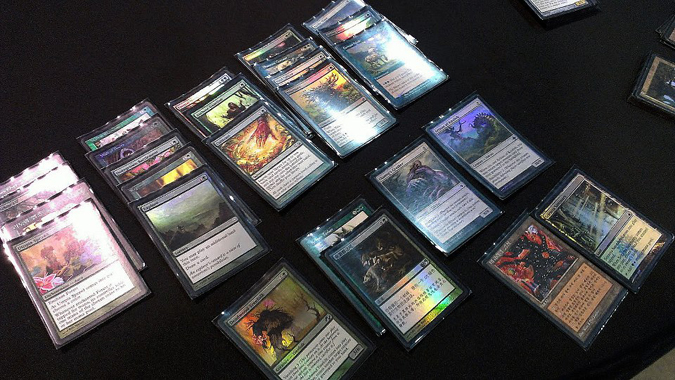
"Mono-Green Ramp"
- Creatures (16)
- 1 Acidic Slime
- 1 Arbor Elf
- 1 Artisan of Kozilek
- 1 Axebane Guardian
- 1 Briarhorn
- 1 Deadwood Treefolk
- 1 Eternal Witness
- 1 Fyndhorn Elves
- 1 Krosan Tusker
- 1 Llanowar Elves
- 1 Overgrown Battlement
- 1 Phantom Centaur
- 1 Ulamog's Crusher
- 1 Vital Splicer
- 1 Wall of Blossoms
- 1 Wall of Roots
- Spells (8)
- 1 Sprout Swarm
- 1 Cultivate
- 1 Explore
- 1 Harmonize
- 1 Howl of the Night Pack
- 1 Regrowth
- 1 Centaur Glade
- 1 Utopia Sprawl
- Lands (16)
- 14 Forest
- 1 Mishra's Factory
- 1 Selesnya Sanctuary
This mono-green deck from a Draft at GP: Pittsburgh featured Sprout Swarm, Centaur Glade, and Howl of the Night Pack to negate the power of two-for-one removal. Flametongue Kavus are simply not enough when your opponents are making multiple 3/3s a turn. While cards such as Sprout Swarm, Centaur Glade, and Howl of the Night Pack can certainly be classified as value cards, the latter two both require a heavy color commitment and end games quickly rather than grind the opponent through small card advantage. These are the sorts of cards that define ramp strategies. While there are many redundant ramp spells in the C/Ube, these effects are fewer between and should be prioritized. Other examples include Grizzly Fate, Pelakka Wurm, Trostani's Summoner, and Eldrazi creatures.
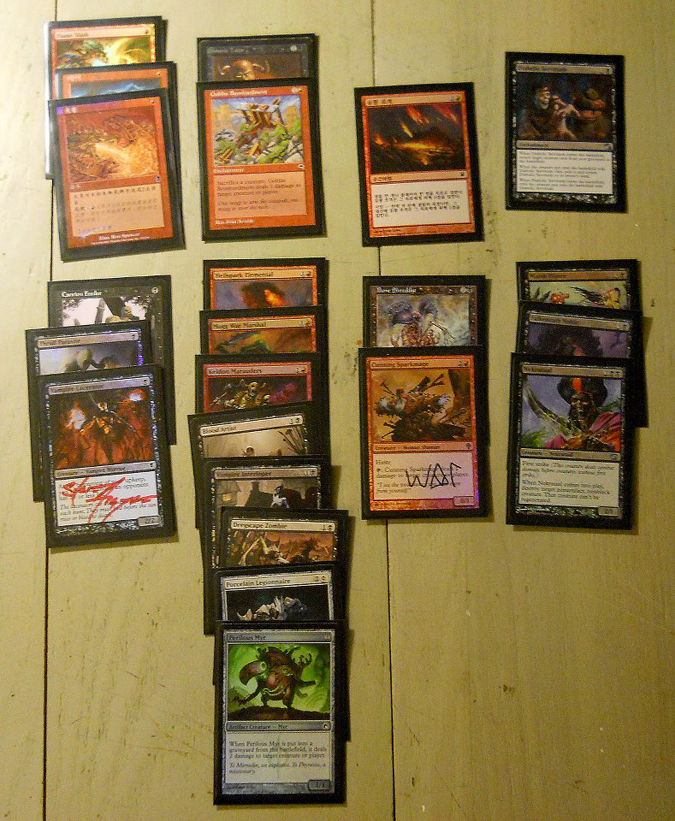
"B/R Sacrifice"
- Creatures (16)
- 1 Blood Artist
- 1 Bone Shredder
- 1 Carrion Feeder
- 1 Cunning Sparkmage
- 1 Dregscape Zombie
- 1 Falkenrath Noble
- 1 Hellspark Elemental
- 1 Keldon Marauders
- 1 Marsh Flitter
- 1 Mogg War Marshal
- 1 Nekrataal
- 1 Thrull Parasite
- 1 Vampire Interloper
- 1 Vampire Lacerator
- 1 Perilous Myr
- 1 Porcelain Legionnaire
- Spells (7)
- 1 Brimstone Volley
- 1 Lightning Bolt
- 1 Demonic Tutor
- 1 Firebolt
- 1 Flame Slash
- 1 Diabolic Servitude
- 1 Goblin Bombardment
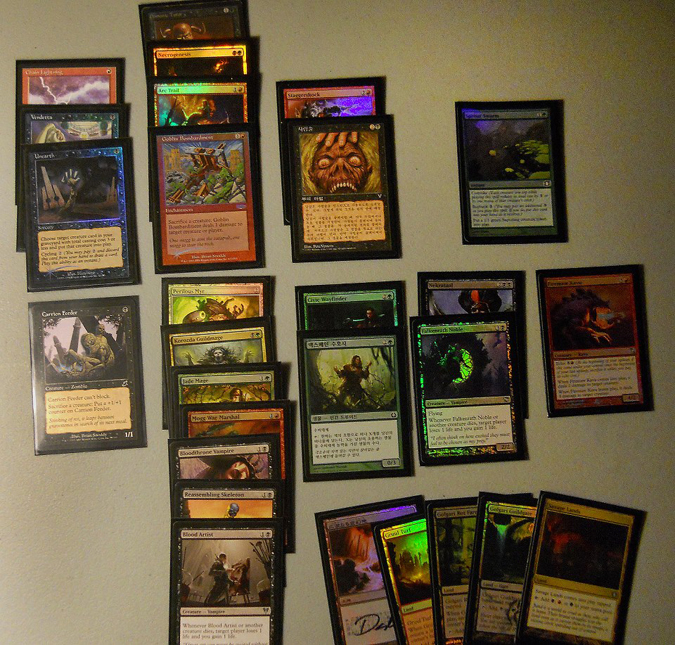
"Jund Sacrifice"
- Creatures (13)
- 1 Axebane Guardian
- 1 Blood Artist
- 1 Bloodthrone Vampire
- 1 Carrion Feeder
- 1 Civic Wayfinder
- 1 Falkenrath Noble
- 1 Firemaw Kavu
- 1 Jade Mage
- 1 Korozda Guildmage
- 1 Mogg War Marshal
- 1 Nekrataal
- 1 Reassembling Skeleton
- 1 Perilous Myr
- Spells (10)
- 1 Sprout Swarm
- 1 Staggershock
- 1 Vendetta
- 1 Arc Trail
- 1 Chain Lightning
- 1 Demonic Tutor
- 1 Unearth
- 1 Goblin Bombardment
- 1 Necrogenesis
- 1 Necromancy
- Lands (17)
- 3 Forest
- 3 Mountain
- 6 Swamp
- 1 Golgari Guildgate
- 1 Golgari Rot Farm
- 1 Gruul Turf
- 1 Savage Lands
- 1 Terramorphic Expanse
One recent archetype addition to the C/Ube is the B/R(/g) sacrifice deck. While there are no true combo decks in C/Ube, this archetype feels very comboish in gameplay. The strategy revolves around Blood Artist, Falkenrath Noble, and Hissing Iguanar in combination with any number of sacrifice effects (the most powerful being Goblin Bombardment). On the surface, the core of these decks can look like two-colored aggro or midrange depending on the build. The essential cards can be difficult to assemble (their only slight overlap with other existing strategies helps), but the ability to kill opponents out of seemingly nowhere is unprecedented in C/Ube.
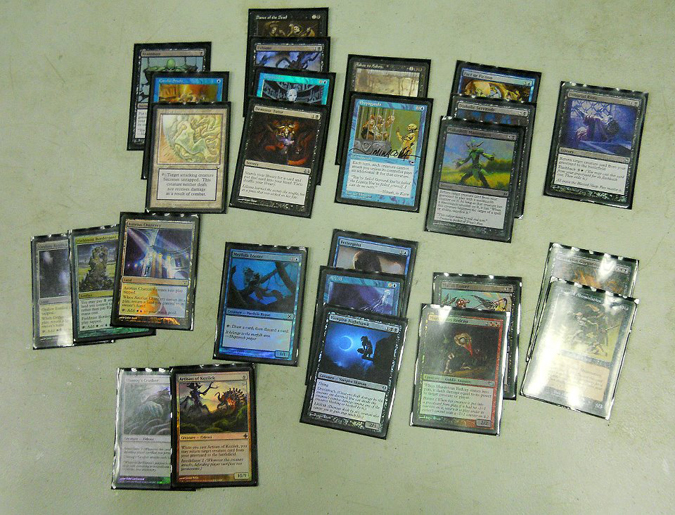
"Reanimator"
- Creatures (10)
- 1 Artisan of Kozilek
- 1 Fettergeist
- 1 Man-o'-War
- 1 Marsh Flitter
- 1 Merfolk Looter
- 1 Murderous Redcap
- 1 Phyrexian Gargantua
- 1 Twisted Abomination
- 1 Ulamog's Crusher
- 1 Vampire Nighthawk
- Spells (13)
- 1 Fact or Fiction
- 1 Makeshift Mannequin
- 1 Ashes to Ashes
- 1 Careful Study
- 1 Demonic Tutor
- 1 Exhume
- 1 Reanimate
- 1 Unburial Rites
- 1 Compulsion
- 1 Dance of the Dead
- 1 Diabolic Servitude
- 1 Propaganda
- 1 Fieldmist Borderpost
- Lands (17)
- 6 Island
- 8 Swamp
- 1 Azorius Chancery
- 1 Maze of Ith
- 1 Orzhov Basilica
Reanimator’s single-minded game plan also feels very much like a combo deck; it’s capable of reanimating 10/9s and Trostani's Summoner’s as early as turn two. Reanimator functions much like the U/B value decks, but like Ramp, it looks to put games away quickly rather than grind advantage. The strategy is one I like a lot because of how redundant many of its pieces are. They can be grouped into three fairly obvious categories: discard, reanimation, and large, powerful creatures. The latter are by far the hardest to come by, but unlike rare Cubes, you’re more than happy Animate Deading a Murderous Redcap, in which case I admit, you’re mostly a value deck. Really, though, we’re looking for those Eldrazi.
Value Decks (a.k.a. The Bad Guy)
The value archetype’s picks are by far the most flexible, so rather than highlight key cards (essentially, you’re just looking for a reasonable curve and power), I’d rather explore why this archetype can give the whole C/Ube a bad rap.
The majority of ways to draft this archetype are blue-based, which presents a whole slew of difficulties. When multiple players aren’t willing to take risks and hedge with unfocused blue cards, everyone ends with a pile of draw spells and removal of near-equal power level. The decks are far from bad (which also makes them enticing) but do lack a lot of proactivity.
So, why does this happen to the value decks and not to other archetypes? The answer has a lot to do with signaling. If I’m looking to draft mono-red, I can quickly deduce if another player near me is also drafting the archetype. The red will simply dry up fairly quickly. Luckily in that instance, there’s time to get out; or, if that other person is downstream, push that player out. This is much harder to see when all you’re interested in is powerful card-generating spells. Additionally, more narrow cards such as Carrion Feeder and Fireblast will often go very late, providing further value for drafting narrower archetypes. Those cards don’t exist for value decks.
I suppose the best reason to draft this archetype would be if you did have it all to yourself, which, unsurprisingly, never happens. Still, value decks remain well-poised against the aggro decks, as early removal and two-for-ones can be a lot to handle without the right draws.
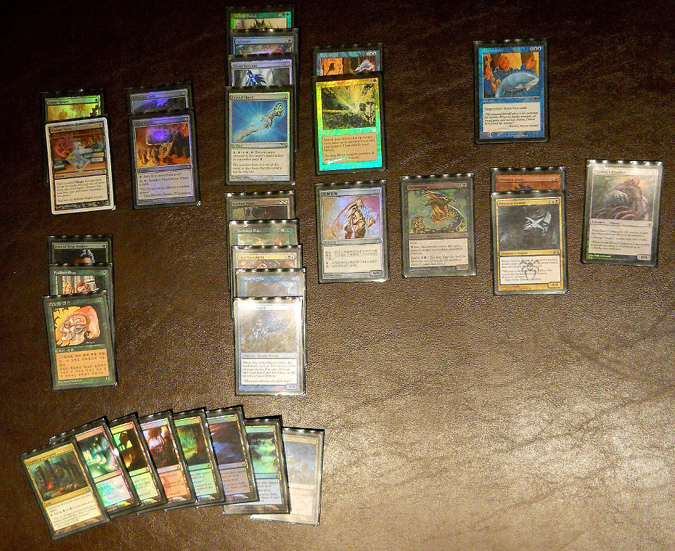
"Four-Colored Value"
- Creatures (14)
- 1 Dinrova Horror
- 1 Elves of Deep Shadow
- 1 Firemaw Kavu
- 1 Fyndhorn Elves
- 1 Kitchen Finks
- 1 Krosan Tusker
- 1 Llanowar Elves
- 1 Man-o'-War
- 1 Sea Gate Oracle
- 1 Shardless Agent
- 1 Shriekmaw
- 1 Ulamog's Crusher
- 1 Yavimaya Elder
- 1 Etched Oracle
- Spells (10)
- 1 Booster Tutor
- 1 Opportunity
- 1 Cultivate
- 1 Explosive Vegetation
- 1 Control Magic
- 1 Utopia Sprawl
- 1 Crystal Shard
- 1 Dimir Keyrune
- 1 Mind Stone
- 1 Prismatic Lens
- Lands (16)
- 1 Island
- 1 Mountain
- 1 Swamp
- 5 Forest
- 1 Crumbling Necropolis
- 1 Gruul Turf
- 1 Izzet Boilerworks
- 1 Jwar Isle Refuge
- 1 Simic Growth Chamber
- 1 Vivid Creek
- 1 Vivid Grove
- 1 Vivid Marsh
Four-colored value is probably the least-drafted version, as all the pieces are difficult to assemble, and the results are often not very good. Above is a very lucky Sealed build.
Building for the Best Play Experience
I wanted to write this article not only because I believed there to be a misunderstanding as to the nature of the C/Ube environment, but also because archetypes are largely connected with providing the best play experience in your own Cube. I spoke earlier about how inclusions that are weak on the surface tend to have purpose, and it’s important for that to be true. Rewarding a player who picked up on what such a card might mean is hugely gratifying and will make that player want to come back for more. A Cube is only useful with players to draft it, so making it both challenging and fun is essential for its longevity. Further, supporting archetypes that aren’t successful is a major pitfall. Take Welkin Tern for example. It’s a better Vampire Interloper on the surface, but it’s in a color that doesn’t support aggressive strategies. A less obvious example is Loam Lion. While that card is clearly fine and in aggressive colors, the G/W combination is fairly lackluster.
There’s a lot think about when it comes to working on and drafting a Cube. Like Magic, the environment is constantly changing. Of course, that’s a lot about what makes cubing so fantastic. While often we’re at the command of R&D when it comes to solving Constructed formats, the fate of a Cube lies in the hands of its creator and those who draft it. Maybe that’s a little romantic, but you can expect that to happen when you fall for this format.
















